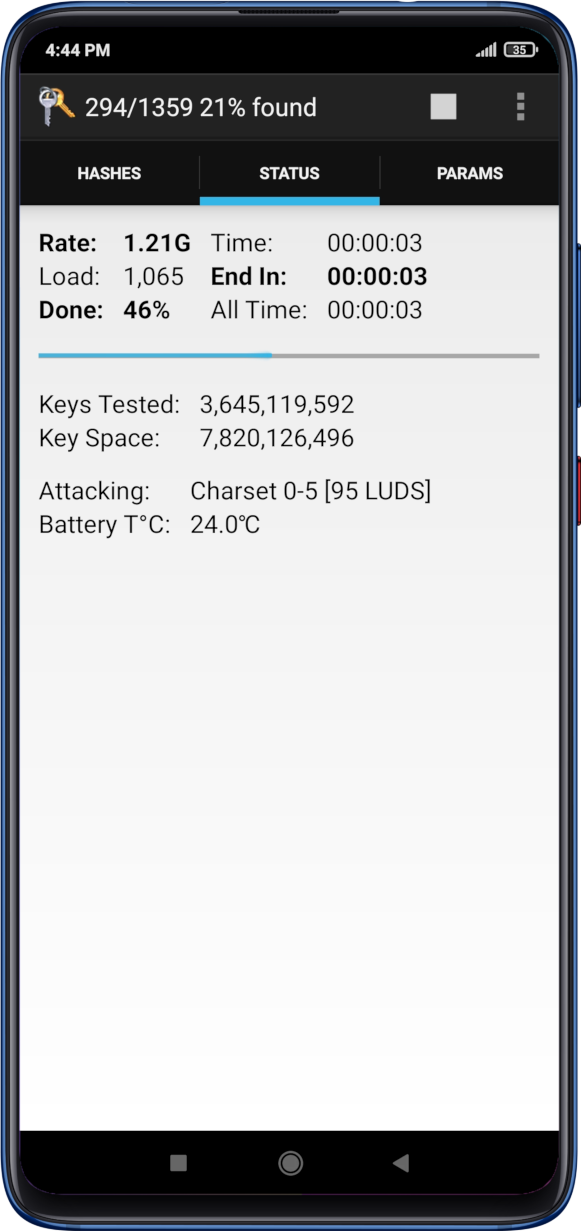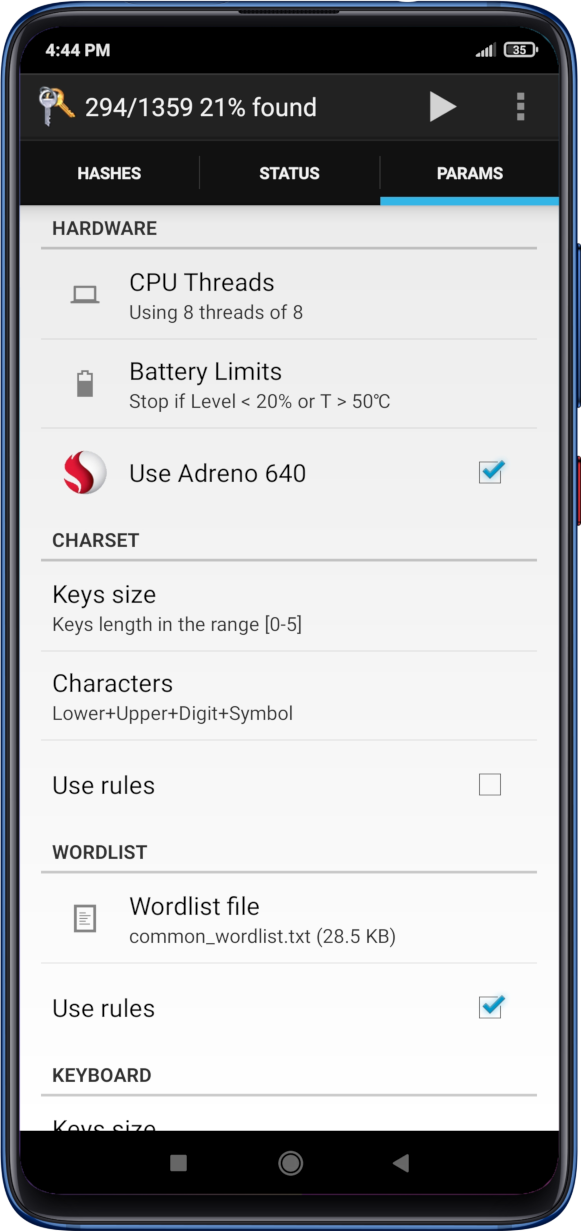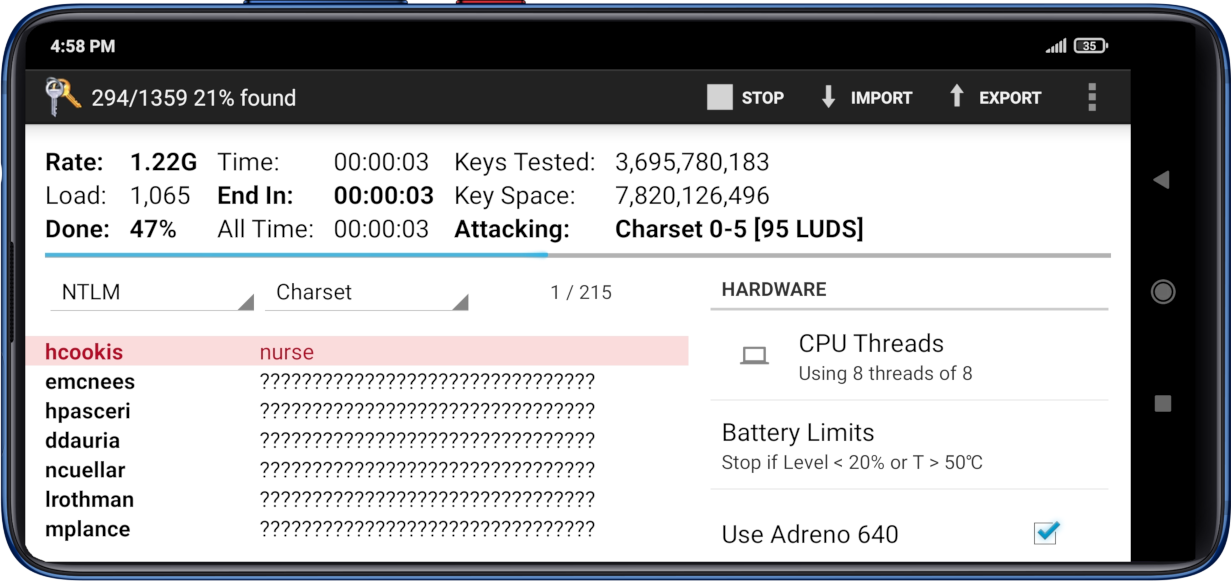Hash Suite Droid (Hash Suite for Android). Free and Open Source.
Hash Suite Droid is, as far as we're aware, the first multi-hash cracker developed specifically for Android devices (as compared to the rather rough unofficial builds of John the Ripper for Android). Features highlight:
- Supports 13 hash types: LM, NTLM, MD5, SHA-1, SHA-256, SHA-512, DCC, DCC2, SSHA, md5crypt, bcrypt, sha256crypt, sha512crypt. Imports hashes of these types from text files with each line containing a bare hash or a username:hash pair or being in PWDUMP tools' output format (for LM and NTLM).
- Supports WiFi WPA PSK (pre-shared key) with import from pcap or hccapx network traffic capture file formats.
- UI optimizes to screen size: The UI changes depending on the screen size. For example, with small-screen smartphones Hash Suite Droid shows 3 tabs (fig 1, 2, 3), whereas with tablets it shows all functionality on one screen (fig 4).
- Cracking On: Pressing the power button while cracking shuts down the screen, but the cracking continues. Cracking also continues if the user starts another app. To stop the attack, users need to press the Stop action item or close Hash Suite Droid.
- Battery aware: Hash Suite Droid automatically stops attacks when the battery's charge drops below or the temperature rises above a user-defined threshold.
- Common "config.db" file: Users can import/export (interchange) the config.db file and use it either on the PC or on the phone or tablet. For example, users can begin an attack on their smartphone/tablet and finish it with Hash Suite for Windows on a PC, or vice versa.
- Features similar to the PC version: Rules, compressed wordlists, ability to resume interrupted attacks, high performance (hand-crafted ARM NEON assembly code, GPU cracking via OpenCL), etc. Reports is the only feature currently not supported.

Fig 1: Hashes Tab. |

Fig 2: Status Tab. |

Fig 3: Params Tab. |

Fig 4: Hash Suite Droid in landscape mode.
Download Hash Suite Droid 1.6 locally [free] (2.2 MB)
Hash Suite Droid source code on GitHub [licensed under GPLv2+]
Requirements:
- Android 4.4 or newer.
- ARM CPU supporting armeabi-v7a or arm64-v8a.
- INTERNET permission to download wordlists.
- WAKE_LOCK permission to prevent Android from putting the CPU to sleep while cracking.
Performance
Hash Suite Droid 1.2 uses 231MB of RAM cracking 1 million NTLM hashes.
Hash Suite Droid 1.2 performance, running on a Qualcomm Snapdragon 801, was compared with an Intel Core i5-4670. Both SOCs are modern, popular, have 4 cores, SIMD capabilities (AVX2 vs Neon) and an integrated GPU. Performance is measured in millions of candidate passwords tested per second.
| Processor Name | Frequency | L1 | L2 | L3 | RAM | Other Information | |
|---|---|---|---|---|---|---|---|
 |
Intel Core i5-4670 | 3.40GHz | 64KB | 256KB | 6MB | 8GB DDR3-1600 | Windows 8.1 Professional 64-bit |
| Intel HD 4600 | 1.2GHz | 8KB | 2MB | 6MB | 1.2GB | Driver 10.18.10.3621 | |
 |
Krait 400 | 2.46GHz | 32KB | 2MB | 0 | 2GB LPDDR3-933 | Samsung Galaxy S5 with Android 5.0 |
| Adreno 330 | 578MHz | 32KB | 0 | 0 | 853MB | Driver Build: 10/28/14 |
| Format | Ratio* | Processor Name | 1 | 10 | 100 | 1000 | 104 | 65536 | 105 | 106 |
|---|---|---|---|---|---|---|---|---|---|---|
| LM | 9.0 | 11 | Intel Core i5-4670 | 621 | 567 | 540 | 499 | 496 | 462 | 439 | 229 |
| Krait 400 | 66.6 | 65.9 | 59.9 | 54.9 | 47.3 | 40.5 | 37.9 | 21.8 | ||
| 10 | 11 | Intel HD 4600 | 175 | 170 | 151 | 154 | 160 | 160 | 156 | 150 | |
| Adreno 330 | 15.9 | 16.3 | 16.3 | 15.5 | 15.6 | 15.2 | 14.8 | 11.5 | ||
| NTLM | 6.9 | 9.9 | Intel Core i5-4670 | 454 | 451 | 446 | 435 | 438 | 429 | 410 | 284 |
| Krait 400 | 66.5 | 67.6 | 65 | 60.9 | 50.9 | 46.2 | 42 | 23.7 | ||
| 2.3 | 4.1 | Intel HD 4600 | 434 | 289 | 290 | 288 | 286 | 286 | 284 | 282 | |
| Adreno 330 | 215 | 127 | 128 | 113 | 103 | 83.9 | 85.1 | 41.5 | ||
| MD5 | 7.0 | 9.0 | Intel Core i5-4670 | 307 | 303 | 302 | 299 | 303 | 296 | 285 | 217 |
| Krait 400 | 44.1 | 45.9 | 42.7 | 41.9 | 37.9 | 33.5 | 31.6 | 21.2 | ||
| 2.7 | 5.0 | Intel HD 4600 | 255 | 209 | 209 | 209 | 208 | 208 | 207 | 205 | |
| Adreno 330 | 125 | 72.2 | 75.6 | 70.8 | 61.3 | 42.9 | 43.1 | 29.4 | ||
| SHA1 | 9.0 | 10.2 | Intel Core i5-4670 | 184 | 184 | 183 | 181 | 177 | 174 | 169 | 140 |
| Krait 400 | 21.7 | 21 | 20 | 19.3 | 18 | 16.8 | 16.4 | 13.6 | ||
| 2.4 | 4.9 | Intel HD 4600 | 88.2 | 87.6 | 87.6 | 87.6 | 87.6 | 87.6 | 87.6 | 87.1 | |
| Adreno 330 | 44.6 | 35.8 | 36.2 | 30.9 | 22.6 | 19.7 | 20.1 | 12.6 | ||
| SHA256 | 10 | 10.9 | Intel Core i5-4670 | 93.5 | 93.5 | 93.1 | 92.7 | 92.2 | 91.1 | 89.2 | 82.6 |
| Krait 400 | 9.35 | 9.65 | 9.24 | 9.16 | 8.72 | 8.33 | 8.21 | 7.46 | ||
| 2.8 | 5.6 | Intel HD 4600 | 34.7 | 33.8 | 33.7 | 33.5 | 33.9 | 34 | 33.7 | 34.1 | |
| Adreno 330 | 17 | 12.3 | 12.6 | 8.91 | 6.57 | 6.22 | 6.29 | 5.25 | ||
| SHA512 | 10 | 10.7 | Intel Core i5-4670 | 34.8 | 34.8 | 34.7 | 34.6 | 34.4 | 33.7 | 33.5 | 31.2 |
| Krait 400 | 3.54 | 3.55 | 3.4 | 3.37 | 3.15 | 3.16 | 3.12 | 3.02 | ||
| 4.9 | 5.5 | Intel HD 4600 | 11 | 10.5 | 10.5 | 10.4 | 10.5 | 10.5 | 10.5 | 10.6 | |
| Adreno 330 | 2.44 | 2.04 | 2.05 | 2.09 | 1.94 | 1.93 | 1.97 | 1.8 | ||
| Format | Ratio* | Processor Name | 1 | 4 | 16 | 64 | ||||
| DCC | 9.8 | Intel Core i5-4670 | 294 | 131 | 39.1 | 10.5 | ||||
| Krait 400 | 33.8 | 14.6 | 3.83 | 0.925 | ||||||
| 3.1 | Intel HD 4600 | 136 | 60.5 | 16.3 | 4.05 | |||||
| Adreno 330 | 57.8 | 25.7 | 4.19 | 1.13 | ||||||
| DCC2 | 11.4 | Intel Core i5-4670 | 10.5K | 2.62K | 0.654K | 0.162K | ||||
| Krait 400 | 1.08K | 0.252K | 0.055K | 0.012K | ||||||
| 2.1 | Intel HD 4600 | 3.37K | 0.819K | 0.205K | 0.051K | |||||
| Adreno 330 | 1.6K | 0.396K | 0.099K | 0.024K | ||||||
| WPA-PSK | 10.1 | Intel Core i5-4670 | 13K | 3.2K | 0.81K | 0.2K | ||||
| Krait 400 | 1.39K | 0.325K | 0.080K | 0.018K | ||||||
| 2.1 | Intel HD 4600 | 4.04K | 1.02K | 0.255K | 0.063K | |||||
| Adreno 330 | 1.94K | 0.486K | 0.121K | 0.030K | ||||||
| BCRYPT | 4.8 | Intel Core i5-4670 | 5.5K | 1.37K | 0.342K | 0.085K | ||||
| Krait 400 | 1.15K | 0.294K | 0.071K | 0.017K | ||||||
| 11.9 | Intel HD 4600 | 575 | 144 | 36 | 9 | |||||
| Adreno 330 | 43 | 11 | 3 | 1 |
We can make some conclusions from this comparative table.
- Mobile performance degrades when cracking more than 1000 hashes.
- LM on mobile GPU has very poor performance.
- When cracking less than 1000 hashes Neon performance (all formats except BCRYPT) is 9.2x slower than AVX2. Mobile non-vectorized code is only 4.8x slower than desktop.
- Mobile GPU performance (other than LM and BCRYPT) is only 2.8x slower than desktop when cracking less than 1000 hashes.
- Mobile GPU performance is 80x slower than high-end desktop GPU (Radeon HD 7970) when cracking 100 NTLM hashes.
Mobile cracking performance is in the order (less than 10x) of medium desktop performance, so mobile cracking is viable if used against a small number of hashes. This is particularly valid for the future given that Moore's Law for desktop is struggling, but for mobile is very much alive. For example the Adreno 430 GPU is theoretically 2.3x faster than the Adreno 330 and the new Adreno 530 GPU is theoretically 3.6x faster.
We recommend SOCs with Adreno GPUs for use with Hash Suite Droid. The majority of mobile vendors use Snapdragon and provide OpenCL drivers already installed (not Nexus, though, because Google blocked OpenCL in their devices). Here's a list of some popular devices:- Sony Xperia Z1, Z2, Z3, Z4, Z5.
- LG G2, G3, G4.
- HTC One M8, M9.
- OnePlus One, 2.
- Samsung Galaxy S5, Note 3, Note 4.
Battery Test
Hash Suite Droid is a power hungry app; we try to measure how it performs on battery. For this test we disabled Wi-Fi, GPS, Bluetooth, and NFC in our Samsung Galaxy S5 Active. We perform an attack on 1000 NTLM hashes beginning with a full charged battery and turning off the screen pressing the power button. The test is performed in a tropical environment with a battery initial temperature of 32°C.
- Cracking with CPU only: The phone warms to 40.9°C, performs at 29M and lasts 120 minutes until the battery reaches 20%. The reduction in performance (2.1x) is caused by Android 5.0 reducing the CPU frequency when the phone warms (known as thermal throttling). Note that the same phone with Android 4.4.2 overheats and reboots, making CPU cracking difficult to achieve.
- Cracking with GPU only: The phone warms to 40.6°C, performs at 103M and lasts 176 minutes until the battery reaches 20%.
When on battery, we recommend cracking using only the GPU given that it is 5.4x more efficient (3.6x faster plus 1.5x less power hungry) than the CPU. If you want to use CPU cracking (for example with LM and BCRYPT formats) we recommend to underclock the CPU for better performance per watt (and to avoid overheating). If you plan to use Hash Suite Droid on the go we recommend the use of tablets (for better battery life) or that you travel with your charger (a spare battery could help too).
Feedback
Please provide comments, suggestions, benchmark results (found in /sdcard/Android/data/com.hashsuite.droid/files/benchmark.csv) and any other feedback.